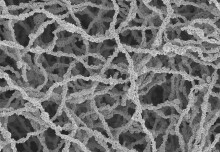

Keith Andrews' paper describing a new method for improving the accuracy of Density Functional Theory (DFT)-based 13C NMR predictions is published
K.G. Andrews, A.C. Spivey, 'Improving the Accuracy of Computed 13C NMR Shift Predictions by Specific Environment Error Correction: Fragment Referencing', J. Org. Chem. 2013, 78, ASAP, DOI: 10.1021/jo401833b.
The accuracy of both Gauge-including atomic orbital (GIAO) and continuous set of gauge transformations (CSGT) 13C NMR spectra prediction by Density Functional Theory (DFT) at the B3LYP/6-31G** level is shown to be usefully enhanced by employing a ‘fragment referencing’ method for predicting chemical shifts without recourse to empirical scaling. Fragment referencing refers to a process of reducing the error in calculating a particular NMR shift by consulting a similar molecule for which the error in the calculation is easily deduced. The absolute accuracy of the chemical shifts predicted when employing fragment referencing relative to conventional techniques (e.g. using TMS or MeOH/benzene dual referencing) is demonstrated to be improved significantly for a range of substrates which illustrate the superiority of the technique particularly for systems with similar chemical shifts arising from different chemical environments. The technique is particularly suited to molecules of relatively low molecular weight containing ‘non-standard’ magnetic environments e.g. a to halogen atoms, which are poorly predicted by other methods. The simplicity and speed of the technique mean that it can be employed to resolve routine structural assignment problems which require a degree of accuracy not provided by standard incremental or hierarchically ordered spherical description of environment (HOSE) algorithms. The approach is also demonstrated to be applicable when employing the MP2 method at 6-31G**, cc-pVDZ, aug-cc-pVDZ and cc-pVTZ levels although none of these offer advantage in terms of accuracy of prediction over the B3LYP/6-31G** DFT method.
Article text (excluding photos or graphics) available under an Attribution-NonCommercial-ShareAlike Creative Commons license.
Photos and graphics subject to third party copyright used with permission or © Imperial College London.
Reporter
Professor Alan C Spivey
Department of Chemistry

Contact details
Tel: +44 (0)20 7594 5841
Email: a.c.spivey@imperial.ac.uk
Show all stories by this author



